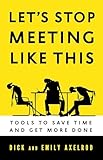Let's stop meeting like this : tools to save time and get more done / Dick and Emily Axelrod.
Material type: TextPublisher: San Francisco, CA : Berrett Koehler Publishers, Inc., [2014]Description: xii, 173 pages : illustrations ; 21 cmContent type: text Media type: unmediated Carrier type: volumeISBN: 9781626560819; 1626560811; 1626560854; 9781626560857; 1459682629; 9781459682627Subject(s): Business meetings | Meetings | Business meetings | MeetingsDDC classification: 658.4/56 LOC classification: HF5734.5 | .A94 2014
TextPublisher: San Francisco, CA : Berrett Koehler Publishers, Inc., [2014]Description: xii, 173 pages : illustrations ; 21 cmContent type: text Media type: unmediated Carrier type: volumeISBN: 9781626560819; 1626560811; 1626560854; 9781626560857; 1459682629; 9781459682627Subject(s): Business meetings | Meetings | Business meetings | MeetingsDDC classification: 658.4/56 LOC classification: HF5734.5 | .A94 2014| Item type | Current library | Call number | Copy number | Status | Notes | Date due | Barcode |
|---|---|---|---|---|---|---|---|
 Books
Books
|
Female Library | HF5734.5 .A94 2014 (Browse shelf (Opens below)) | 1 | Available | STACKS | 51952000237396 | |
 Books
Books
|
Main Library | HF5734.5 .A94 2014 (Browse shelf (Opens below)) | 1 | Checked out | STACKS | 11/03/2022 | 51952000237327 |
Includes bibliographical references (page 149151) and index.
How to get your work done in meetings -- The meeting canoe -- Welcome people -- Connect people to each other and the task -- Discover the way things are -- Elicit people's dreams -- Decide -- Attend to the end -- First aid for meetings -- Metting basics : five steps to meeting success -- Leaders : three steps to meeting effectiveness -- Contributors : three steps to meeting effectiveness -- Facilitators : three steps to meeting effectiveness -- Our handoff to you.
Most people regard meetings as places where productivity goes to die. How different would it be if they were places where you could actually get your work done - right there in the meeting? Richard and Emily Axelrod have invested thirty years answering this question, and they have a field-tested answer. Using the same work design principles that transformed the mind-numbing assembly line into the dynamic factory floor, and that make video games so engaging, their new book offers a flexible, repeatable process that has already been used to run thousands of productive meetings in all kinds of organizations. It takes more than an agenda and a note-taker. The Axelrods show how to design every aspect of a meeting - from the way you greet people at the beginning to how you sum up at the end - so that the experience will be energizing rather than enervating, and relevant and helpful to every participant. Their detailed, six-stage approach, which they dub the Meeting Canoe (since, like a canoe, it adapts to changing conditions and is a collective effort) is a seismic shift in the way we view, use, and participate in meetings. The many current users of this system will never go back. Neither will you.
1 2

There are no comments on this title.